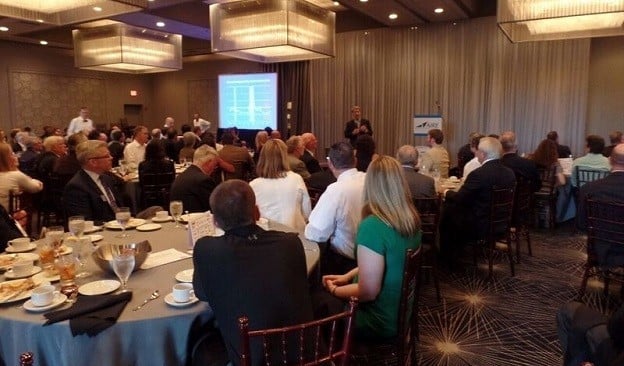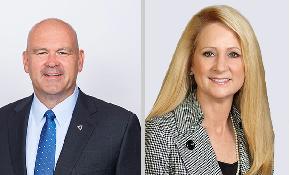 David Oppedahl of the Federal Reserve at Gene & Georgetti’s in Rosemont, IL, on Tuesday.
David Oppedahl of the Federal Reserve at Gene & Georgetti’s in Rosemont, IL, on Tuesday.
CHICAGO—David Oppedahl, a senior business economist with the Federal Reserve’s Chicago office, told more than 350 members of AIRE and SIOR at a joint luncheon meeting this week that today’s economy is a classic example of the tortoise and the hare, performing at fits and starts in a variety of key categories.
Oppedahl was sharing with industrial real estate brokers and developers better his view on how far the economy has come and where it’s headed for the balance of 2016 and in the years ahead.
“Based on what I’ve seen in the field and the comments I heard today, I am encouraged by the steadiness of the recovery and for the near term outlook,” said Adam Roth, SIOR president and an executive vice president with NAI Hiffman. “Every indication is that the industrial market should continue to expand for another couple of years, in spite of what may be weaknesses in other sectors.”
In kicking off his Tuesday presentation at Gene & Georgetti’s in suburban Rosemont, Oppedahl noted “the trajectory of this recovery has been below that of past recessions with previous levels of growth about double what they have been during this recovery.”
He reported that the current recovery period, while producing less of a bounce, has been more sustained than other recoveries. He added that the 1974-1975 recovery already had ended by now and that another recession had begun.
The Fed uses the federal funds rate as a tool to stimulate the economy, and Oppedahl said keeping interests low for so long was, in essence, “the Federal Reserve pushing the accelerator to the floor. But you can’t push the pedal through the floor, so we need other factors besides interest rates to contribute.”
One possibility is inflation. Oppedahl pointed out that inflation has been zero or very slight, except for food and energy, and said the FOMC will continue to monitor economic conditions to tailor future actions to meet its objectives of maximum employment and 2% inflation.
“We see a bit of inflation, but not enough to be concerned,” he said. “The FOMC targets about two percent, and we are below that. The US is not like Europe where inflation has been out of sync with the rest of the economy.”
The Fed executive praised the strength of the dollar worldwide, pointing out that it gives us greater buying power for imported goods. But that same strong dollar makes it harder for our manufacturers to sell products abroad.
“That tells me companies that rely heavily on exports may grow at a slower rate this year and next,” said John Coleman, a member of AIRE’s board as well as an executive vice president at Transwestern and head of the industrial practice. “We’re working with manufacturers and distributors that can exploit the positive dynamics of the recovering economy.”
Oppedahl spent a considerable amount of time talking about employment issues and trends, declaring that the US economy has seen good year-over-year job growth—better than in past recoveries. “We’ve replaced what we have lost,” he said. But he addressed that there may be concerns that what has been gained in the number of jobs has not been equaled in the quality of those jobs.
He also noted that while the Midwest is performing well, Illinois, with its Springfield issues, lags behind the rest of the county in jobs and recovery metrics.
As a nation, he said, “things are looking good, but there are some concerns.” Those concerns include:
- Level of long-term unemployed—our unemployed remains unemployed for a longer period of time than in past recoveries. This results in workers settling for lesser jobs than they may be qualified for.
- Labor force participation—this rate, the number of employable people actually employed, has been declining and is at 63% after peaking about five years ago at 67%.
- Wages growth remains weak—wage increases which were expected in the 7% range are now at about 1%.
Oppedahl concluded by saying he expects GDP to continue growing. “It may not be real strong, but it will be growth; kind of like the tortoise and the hare.”

















 Copyright © 2024 ALM Global, LLC. All Rights Reserved.
Copyright © 2024 ALM Global, LLC. All Rights Reserved.